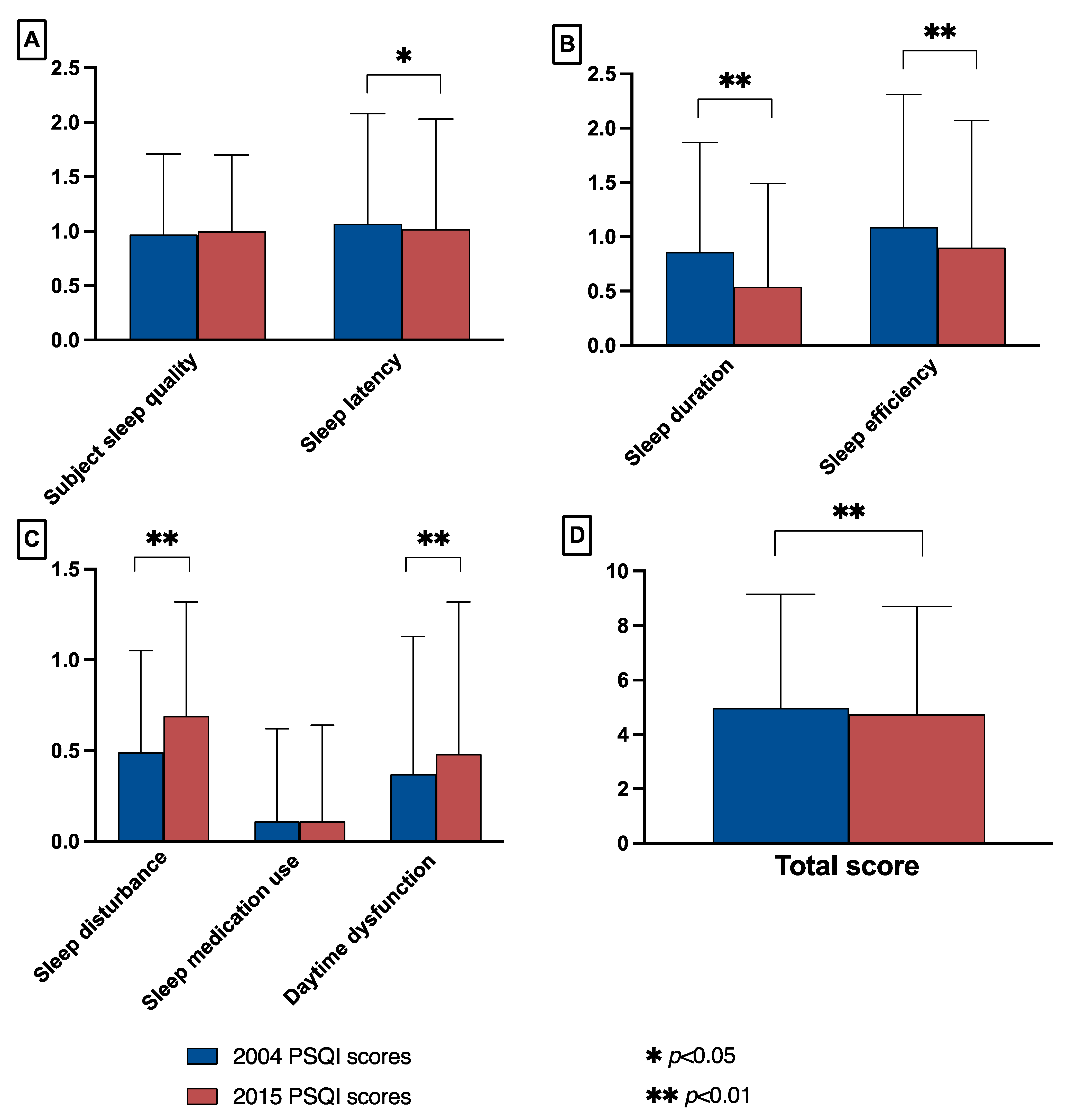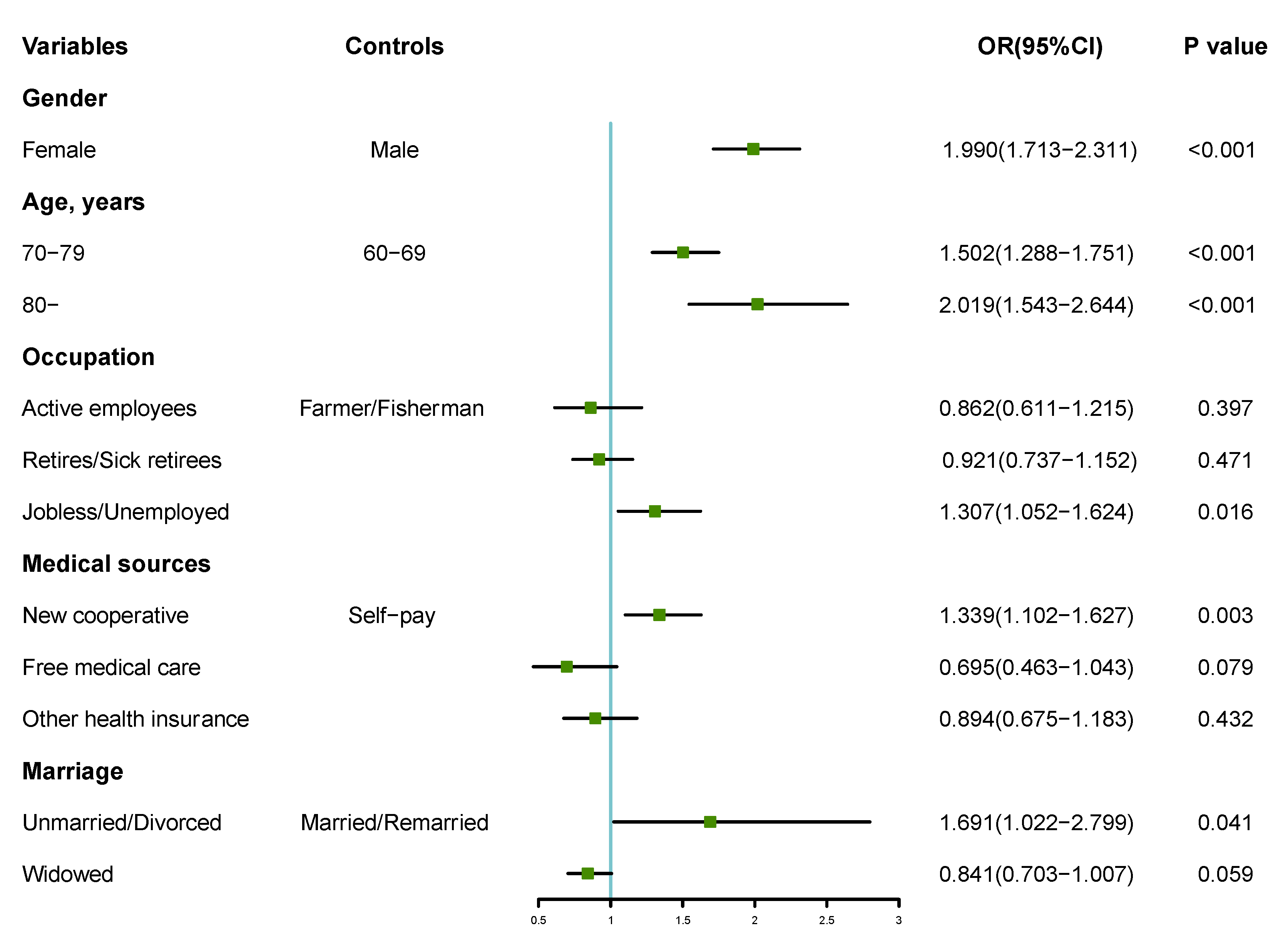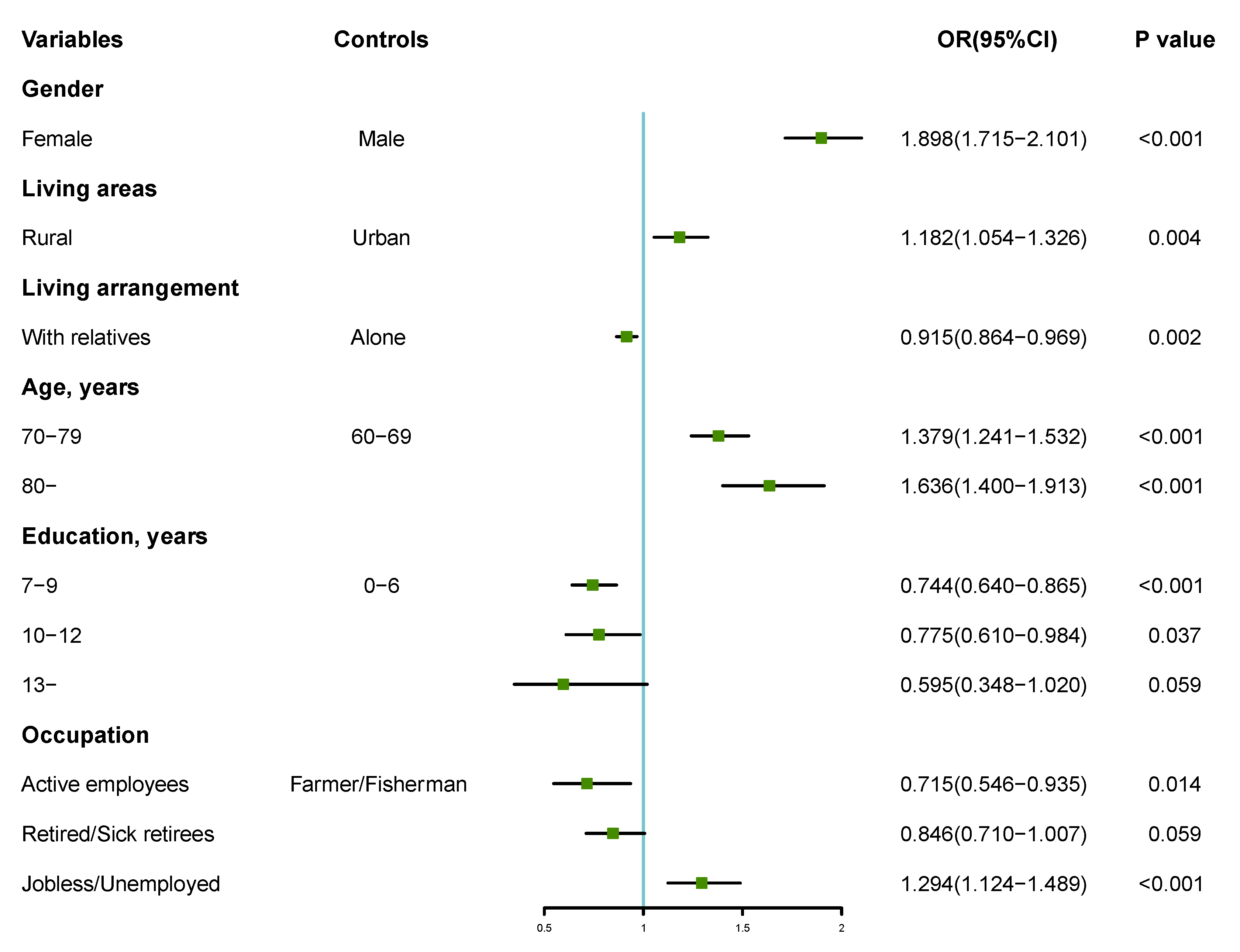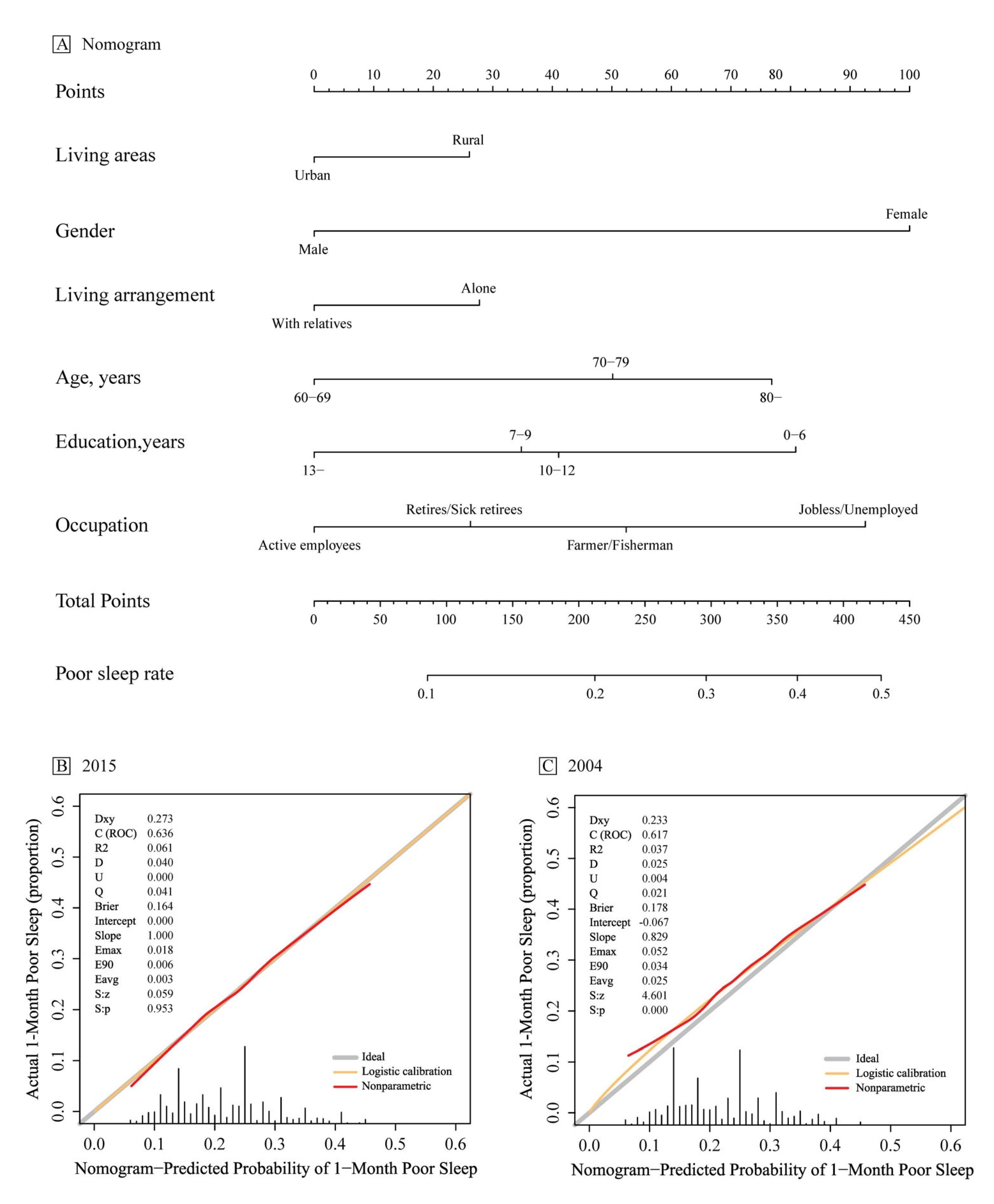Sleep Quality among the Elderly in 21st Century Shandong Province, China: A Ten-Year Comparative Study
Abstract
1. Introduction
2. Methods
2.1. Study Population
2.2. Study Tools
2.3. Study Design
2.4. Statistical Analyses
3. Results
3.1. Prevalence of Poor Sleep Quality
3.2. Average Sleep Duration
3.3. PSQI Scores
3.4. Multi-Factorial Analysis of Sleep Quality
4. Discussion
5. Strengths and Limitations
6. Conclusions
Author Contributions
Funding
Institutional Review Board Statement
Informed Consent Statement
Data Availability Statement
Acknowledgments
Conflicts of Interest
References
- Chang, A.Y.; Skirbekk, V.F.; Tyrovolas, S.; Kassebaum, N.J.; Dieleman, J.L. Measuring population ageing: An analysis of the Global Burden of Disease Study 2017. Lancet Public Health 2019, 4, e159–e167. [Google Scholar] [CrossRef]
- The Lancet Public Health. Ageing: A 21st century public health challenge? Lancet Public Health 2017, 2, E297. [Google Scholar] [CrossRef]
- The Lancet Healthy Longevity. Care for ageing populations globally. Lancet Healthy Longev. 2021, 2, e187–e188. [Google Scholar]
- China NBoSo. Major Figures on 2020 Population Census of China. Available online: http://www.stats.gov.cn/tjsj/pcsj/rkpc/d7c/202111/P020211126523667366751.pdf (accessed on 15 April 2022).
- Lu, L.; Wang, S.-B.; Rao, W.; Zhang, Q.; Ungvari, G.S.; Ng, C.H.; Kou, C.; Jia, F.-J.; Xiang, Y.-T. The Prevalence of Sleep Disturbances and Sleep Quality in Older Chinese Adults: A Comprehensive Meta-Analysis. Behav. Sleep Med. 2018, 17, 683–697. [Google Scholar] [CrossRef]
- Gulia, K.K.; Kumar, V.M. Sleep disorders in the elderly: A growing challenge. Psychogeriatrics 2018, 18, 155–165. [Google Scholar] [CrossRef]
- Khan, M.S.; Aouad, R. The Effects of Insomnia and Sleep Loss on Cardiovascular Disease. Sleep Med. Clin. 2017, 12, 167–177. [Google Scholar] [CrossRef]
- Spira, A.P.; Chen-Edinboro, L.; Wu, M.N.; Yaffe, K. Impact of sleep on the risk of cognitive decline and dementia. Curr. Opin. Psychiatry 2014, 27, 478–483. [Google Scholar] [CrossRef]
- Itani, O.; Jike, M.; Watanabe, N.; Kaneita, Y. Short sleep duration and health outcomes: A systematic review, meta-analysis, and meta-regression. Sleep Med. 2016, 32, 246–256. [Google Scholar] [CrossRef]
- Becker, N.B.; Jesus, S.N.; João, K.A.D.R.; Viseu, J.N.; Martins, R.I.S. Depression and sleep quality in older adults: A meta-analysis. Psychol. Health Med. 2016, 22, 889–895. [Google Scholar] [CrossRef]
- Garbarino, S.; Lanteri, P.; Durando, P.; Magnavita, N.; Sannita, W.G. Co-Morbidity, Mortality, Quality of Life and the Healthcare/Welfare/Social Costs of Disordered Sleep: A Rapid Review. Int. J. Environ. Res. Public Health 2016, 13, 831. [Google Scholar] [CrossRef]
- Tarokh, L.; Saletin, J.M.; Carskadon, M.A. Sleep in adolescence: Physiology, cognition and mental health. Neurosci. Biobehav. Rev. 2016, 70, 182–188. [Google Scholar] [CrossRef] [PubMed]
- Shochat, T.; Cohen-Zion, M.; Tzischinsky, O. Functional consequences of inadequate sleep in adolescents: A systematic review. Sleep Med. Rev. 2014, 18, 75–87. [Google Scholar] [CrossRef] [PubMed]
- Abiddine, F.Z.E.; Aljaberi, M.A.; Gadelrab, H.F.; Lin, C.Y.; Muhammed, A. Mediated effects of insomnia in the association between problematic social media use and subjective well-being among university students during COVID-19 pandemic. Sleep Epidemiol. 2022, 2, 100030. [Google Scholar] [CrossRef]
- Zhang, J.; Wang, R.; Wang, C.; Wang, Y.; Chen, X.; Mi, G.; Chen, X.; Cheng, X.; Wang, L.; Wu, X.; et al. Prevalence of mental disorders in 21st century Shandong Province, China: A ten-year comparative study. J. Affect. Disord. 2021, 283, 344–353. [Google Scholar] [CrossRef] [PubMed]
- Buysse, D.J.; Reynolds, C.T., 3rd; Monk, T.H.; Berman, S.R.; Kupfer, D.J. The Pittsburgh sleep quality index—A new instrument for psychiatric practice and research. Psychiatry Res. 1989, 28, 193–213. [Google Scholar] [CrossRef]
- Liu, X.; Tang, M.; Hu, L.; Wang, A.; Wu, H.; Zhao, G.; Gao, C.; Li, W. Rellability and validity of the Pittsburgh sleep quality index. Chin. J. Psychiatry 1996, 29, 103–107. [Google Scholar]
- Zhang, H.; Li, Y.; Zhao, X.; Mao, Z.; Abdulai, T.; Liu, X.; Tu, R.; Wang, Y.; Qian, X.; Jiang, J.; et al. The association between PSQI score and hypertension in a Chinese rural population: The Henan Rural Cohort Study. Sleep Med. 2019, 58, 27–34. [Google Scholar] [CrossRef]
- Wang, Q.; Zhang, J.; Wang, R.; Wang, C.; Wang, Y.; Chen, X.; Mi, G.; Chen, X.; Cheng, X.; Wang, L.; et al. Sleep quality as a mediator of the association between coping styles and mental health: A population-based ten-year comparative study in a Chinese population. J. Affect. Disord. 2021, 283, 147–155. [Google Scholar] [CrossRef]
- China NBoSo. China Statistical Yearbook 2021. Available online: http://www.stats.gov.cn/tjsj/ndsj/2021/indexch.htm (accessed on 15 April 2022).
- Rodriguez, J.C.; Dzierzewski, J.M.; Alessi, C.A. Sleep Problems in the Elderly. Med. Clin. N. Am. 2014, 99, 431–439. [Google Scholar] [CrossRef]
- Yu, L.; Liyuan, M.; Yin, X.; Belton, F. Supported or Supporting? Family Structure and Employment Choice of the Elderly in Urban China. Labor Econ. Res. 2016, 4, 24–54. [Google Scholar]
- Ma, G.; Cai, L.; Yang, J.; Shen, J.R.; Liu, Y.N.; Cui, W.L.; He, J.H. Analysis of socioeconomic differences for prevalence of sleep disorder among rural elder adults in Ninger county of Yunnan province. Mod. Prev. Med. 2019, 46, 3724–3727. [Google Scholar]
- Wu, X.; Chen, X.; Jiang, X.; Yang, S.; Lu, H.; Feng, Y.; Zhou, L.; Li, B.; Luo, J.; Yao, Y. Sleep quality of elderly people in Chengdu and its influencing factors. Chin. J. Gerontol. 2021, 41, 189–191. [Google Scholar]
- Stone, K.L.; Xiao, Q. Impact of Poor Sleep on Physical and Mental Health in Older Women. Sleep Med. Clin. 2018, 13, 457–465. [Google Scholar] [CrossRef] [PubMed]
- Wang, K.; Song, R.; Zhu, Z. Investigation of Emotional State and Sleep Quality for Adult in Xi’an City. China J. Health Psychol. 2016, 24, 1100–1105. [Google Scholar]
- Chen, J.; Zhang, D.; Fan, W. Income Regulation Effect of Agricultural and Rural Modernization in Rural Revitalization: An Empirical Analysis of Shandong Province from the Perspective of Urban-Rural Gap. J. Cent. South Univ. For. Technol. (Soc. Sci.) 2019, 13, 53–60. [Google Scholar] [CrossRef]
- Hu, L.; Chen, X.; Mi, G. Quality of life and its impact factors among adult residents in Shandong province, 2015: A cross-sectional survey. Chin. J. Public Health 2021, 37, 470–474. [Google Scholar] [CrossRef]
- Wang, D. Analysis of the current situation of the life of the elderly left behind under the revitalization of the countryside: A case study of Village D and Village X in W City, Shandong Province. Pract. Rural. Technol. 2021, 1, 61–65. [Google Scholar]
- Wu, W.; Jiang, Y.; Wang, N.; Zhu, M.; Liu, X.; Jiang, F.; Zhao, G.; Zhao, Q. Sleep quality of Shanghai residents: Population-based cross-sectional study. Qual. Life Res. 2019, 29, 1055–1064. [Google Scholar] [CrossRef]
- Xie, Z.; Chen, F.; Li, W.A.; Geng, X.; Li, C.; Meng, X.; Feng, Y.; Liu, W.; Yu, F. A review of sleep disorders and melatonin. Neurol. Res. 2017, 39, 559–565. [Google Scholar] [CrossRef]
- Wang, P.; Zeng, H. Current status of research on sleep disorders in the elderly. Chin. J. Mod. Nurs. 2010, 16, 4454–4456. [Google Scholar]
- Liu, H.; Zhang, R. Advances in the study of sleep quality in the elderly. Chin. J. Gerontol. 2009, 29, 637–639. [Google Scholar]
- Wang, Q.; Granados, J.A.T. Economic growth and mental health in 21st century China. Soc. Sci. Med. 2018, 220, 387–395. [Google Scholar] [CrossRef] [PubMed]
- Wang, X.; Zheng, L. Analysis of Related Influence Factors of Sleep Quality and Life in Senile Patients with Insomnia. Prev. Med. Public Health 2016, 13, 33–35. [Google Scholar] [CrossRef]
- Yang, H.-C.; Suh, S.; Kim, H.; Cho, E.R.; Lee, S.K.; Shin, C. Testing bidirectional relationships between marital quality and sleep disturbances: A 4-year follow-up study in a Korean cohort. J. Psychosom. Res. 2013, 74, 401–406. [Google Scholar] [CrossRef] [PubMed]
- Chen, J.-H.; Waite, L.J.; Lauderdale, D.S. Marriage, Relationship Quality, and Sleep among U.S. Older Adults. J. Health Soc. Behav. 2015, 56, 356–377. [Google Scholar] [CrossRef] [PubMed]
- Weng, Z.; Zhang, J.; Ma, D.; Ma, S.; Li, X.; Jiang, Y.; Xu, L.; Chen, D.; Cao, X.; Meng, G.; et al. A epidemiological investigation of mental disorders in Shandong province in 1984 and 1994. Chin. J. Psychiatry 1998, 31, 222–224. [Google Scholar]




| Variables | 2004 | 2015 | χ2 Value | p Value |
|---|---|---|---|---|
| Gender | 3.66 | 0.056 | ||
| female | 2324 (52.21) | 5873 (53.91) | ||
| male | 2127 (47.79) | 5021 (46.09) | ||
| Living areas | 134.87 | <0.001 | ||
| urban | 1163 (26.13) | 3905 (35.85) | ||
| rural | 3288 (73.87) | 6989 (64.15) | ||
| Age (years) | 48.261 | <0.001 | ||
| 60~69 | 2652 (59.58) | 6508 (59.74) | ||
| 70~79 | 1500 (33.70) | 3302 (30.31) | ||
| ≥80 | 299 (6.72) | 1084 (9.95) | ||
| Education (years) | 71.50 | <0.001 | ||
| 0~6 | 3530 (79.31) | 8253 (75.76) | ||
| 7~9 | 574 (12.90) | 1816 (16.67) | ||
| 10~12 | 223 (5.01) | 667 (6.12) | ||
| ≥13 | 124 (2.79) | 158 (1.45) | ||
| Occupation | 329.69 | <0.001 | ||
| farmer/fisherman | 2446 (54.95) | 7390 (67.84) | ||
| active employees | 231 (5.19) | 496 (4.55) | ||
| retired/sick retirees | 1232 (27.68) | 1691 (15.52) | ||
| jobless/unemployed | 542 (12.18) | 1317 (12.09) | ||
| Living arrangement | 15.49 | <0.001 | ||
| alone | 783 (17.59) | 2219 (20.37) | ||
| with relatives | 3668 (82.41) | 8675 (79.63) | ||
| Medical sources | 8371.98 | <0.001 | ||
| self-pay | 3013 (67.69) | 337 (3.09) | ||
| new cooperative | 636 (14.29) | 8096 (74.32) | ||
| free medical care | 232 (5.21) | 135 (1.24) | ||
| other health insurance | 570 (12.81) | 2326 (21.35) | ||
| Marriage | 11.152 | 0.004 | ||
| married/remarried | 3315 (74.48) | 8370 (76.83) | ||
| unmarried/divorced | 80 (1.80) | 207 (1.90) | ||
| widowed | 1056 (23.73) | 2317 (21.27) | ||
| Total | 4451 (100) | 10,894 (100) |
| Age (Years) | 2004 | 2015 | Standard Population | |||||||||
|---|---|---|---|---|---|---|---|---|---|---|---|---|
| Total Number of Persons | Actual Number of Poor Sleepers | Before Adjustment Prevalence | Adjusted Number of Poor Sleepers | Adjusted Prevalence | Total Number of Persons | Actual Number of Poor Sleepers | Before Adjustment Prevalence | Adjusted Number of Poor Sleepers | Adjusted Prevalence | Number of People | Composition Ratio | |
| 60~64 | 1529 | 322 | 21.1 | 261 | 17.1 | 3616 | 630 | 17.4 | 527 | 14.6 | 73,382,938 | 27.8 |
| 65~69 | 1123 | 232 | 20.7 | 258 | 23.0 | 2892 | 594 | 20.5 | 625 | 21.6 | 74,005,560 | 28.0 |
| 70~74 | 965 | 268 | 27.8 | 233 | 24.1 | 2009 | 486 | 24.2 | 496 | 24.7 | 49,590,036 | 18.8 |
| 75~79 | 535 | 145 | 27.1 | 142 | 26.5 | 1293 | 343 | 26.5 | 341 | 26.3 | 31,238,849 | 11.8 |
| ≥80 | 299 | 103 | 34.5 | 209 | 69.8 | 1084 | 337 | 31.1 | 461 | 42.5 | 35,800,835 | 13.6 |
| Total | 4451 | 1070 | 24.0 | 1103 | 24.8 | 10,894 | 2390 | 21.9 | 2450 | 22.5 | 264,018,218 | 100 |
| Variables | 2004 | 2015 | χ2 Value | Adjusted p-Value | Effect Size | ||||
|---|---|---|---|---|---|---|---|---|---|
| Total Number of Persons | Adjusted Number of Poor Sleepers | Adjusted Prevalence (95% CI) | Total Number of Persons | Adjusted Number of Poor Sleepers | Adjusted Prevalence (95% CI) | ||||
| Gender | |||||||||
| female | 2324 | 718 | 30.9 (29.0~32.8) a | 5873 | 1671 | 28.5 (27.3~29.6) b | 4.81 | 0.028 | 0.07 |
| male | 2127 | 383 | 18.0 (16.4~19.6) | 5021 | 788 | 15.7 (14.7~16.7) | 5.83 | 0.016 | 0.10 |
| Living areas | |||||||||
| urban | 1163 | 263 | 22.6 (20.2~25.0) | 3905 | 795 | 20.4 (19.1~21.6) b | 2.76 | 0.110 | 0.08 |
| rural | 3288 | 836 | 25.4 (23.9~26.9) | 6989 | 1652 | 23.6 (22.6~24.6) | 3.90 | 0.048 | 0.06 |
| Age (years) | |||||||||
| 60~69 | 2652 | 519 | 19.6 (18.1~21.1) a | 6508 | 1152 | 17.7 (16.8~18.6) b | 4.41 | 0.036 | 0.07 |
| 70~79 | 1500 | 375 | 25.0 (22.8~27.2) | 3302 | 837 | 25.3 (23.9~26.8) | 0.07 | 0.797 | −0.01 |
| ≥80 | 299 | 209 | 69.9 (64.7~75.1) | 1084 | 461 | 42.5 (39.6~45.5) | 70.30 | <0.001 | 0.69 |
| Total | 4451 | 1103 | 24.8 (23.5~26.0) | 10,894 | 2450 | 22.5 (21.7~23.3) | 9.33 | 0.002 | 0.23 |
| Variables | 2004 | 2015 | t Value | Adjusted p-Value | Effect Size |
|---|---|---|---|---|---|
| Gender | |||||
| female | 6.97 ± 1.85 a | 7.18 ± 1.94 b | −4.87 | <0.001 | −0.11 |
| male | 7.50 ± 1.64 | 7.64 ± 1.76 | −3.71 | 0.001 | −0.08 |
| Living areas | |||||
| urban | 6.95 ± 1.52 a | 7.19 ± 1.65 b | −4.58 | <0.001 | −0.15 |
| rural | 7.32 ± 1.85 | 7.50 ± 1.98 | −5.25 | <0.001 | −0.09 |
| Age (years) | |||||
| 60~69 | 7.33 ± 1.69 a | 7.46 ± 1.78 b | −3.78 | 0.001 | −0.07 |
| 70~79 | 7.09 ± 1.87 | 7.31 ± 1.89 | −3.91 | <0.001 | −0.12 |
| ≥80 | 6.97 ± 1.96 | 7.26 ± 2.31 | −2.16 | 0.028 | −0.13 |
| Overall | 7.22 ± 1.77 | 7.39 ± 1.88 | −5.76 | <0.001 | −0.09 |
Publisher’s Note: MDPI stays neutral with regard to jurisdictional claims in published maps and institutional affiliations. |
© 2022 by the authors. Licensee MDPI, Basel, Switzerland. This article is an open access article distributed under the terms and conditions of the Creative Commons Attribution (CC BY) license (https://creativecommons.org/licenses/by/4.0/).
Share and Cite
Yue, Z.; Zhang, Y.; Cheng, X.; Zhang, J. Sleep Quality among the Elderly in 21st Century Shandong Province, China: A Ten-Year Comparative Study. Int. J. Environ. Res. Public Health 2022, 19, 14296. https://doi.org/10.3390/ijerph192114296
Yue Z, Zhang Y, Cheng X, Zhang J. Sleep Quality among the Elderly in 21st Century Shandong Province, China: A Ten-Year Comparative Study. International Journal of Environmental Research and Public Health. 2022; 19(21):14296. https://doi.org/10.3390/ijerph192114296
Chicago/Turabian StyleYue, Zenghe, Yi Zhang, Xiaojing Cheng, and Jingxuan Zhang. 2022. "Sleep Quality among the Elderly in 21st Century Shandong Province, China: A Ten-Year Comparative Study" International Journal of Environmental Research and Public Health 19, no. 21: 14296. https://doi.org/10.3390/ijerph192114296
APA StyleYue, Z., Zhang, Y., Cheng, X., & Zhang, J. (2022). Sleep Quality among the Elderly in 21st Century Shandong Province, China: A Ten-Year Comparative Study. International Journal of Environmental Research and Public Health, 19(21), 14296. https://doi.org/10.3390/ijerph192114296





